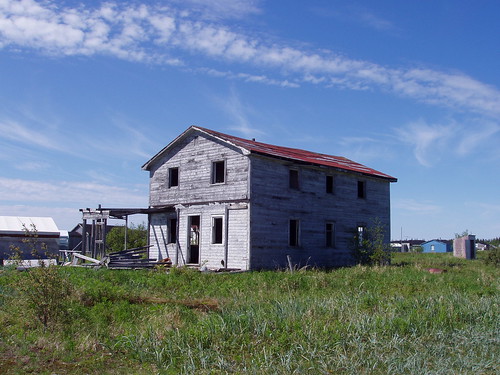Many weeks ago, in this post about hydroelectricity’s environmental footprint, I promised to write about the Cree community that was displaced by the LG hydro complex. I admit that I’ve had a lot of trouble pulling together my thoughts on this touchy subject, but its finally time to give it a go…
I had always thought that Fort George was underwater.
The massive LG hydroelectricity project has diverted 4 rivers into La Grande’s watershed, nearly doubling its volume. Located downriver from the dam, near the mouth of La Grande, Fort George was vulnerable to being washed away if ever the dam were to break. With the dam in place, La Grande’s flow became erratic and ice cover unreliable, transforming the ecosystem on which Cree hunters and fishers have relied for generations. Furthermore, the sandy banks on which the community once stood are rapidly eroding away. In 1980, the year that the LG-2 dam was completed, the Cree community voted to relocate their village to the river bank.
But on a recent trip up North I learned that, for the moment at least, the remains of the abandoned Fort George community are still standing.
Historically, Fort George Island was a summer gathering place for the nomadic Cree hunters. In 1832, a Hudson’s Bay Company trading post was established and the first permanent residents settled. The island was also the site of 2 residential schools, one of which continued to operate until the community relocated in 1979.
Being a fan of urban exploration, I was initially drawn to the idea of visiting the abandoned town. But walking among the collapsing clapboard houses, the keeling-over schoolhouse and the bare church pews, I was overcome with sadness.
I have always found that abandoned places in the city feel liberated, like a covert common space. But an entire abandoned town is a lost soul. Today Fort George stands stripped and weather-beaten, neither restored to nature, nor animated by human inhabitants.
The move away from Fort George was democratic, if reluctant. The villagers voted to relocate and the Band chose a new site for the village. Many buildings were preserved and moved across the river; others were rebuilt.
The new town of Chisasibi is almost as strange as its abandoned counterpart. Built mostly during the architecturally unfortunate years of 1979-80, its commercial centre, boxy school, clustered bungalows, and vast parking lots feel inorganic.
photos: the commercial centre is a place where many elders hang out in the afternoon and the tipi-shaped community centre holds Chisasibi’s restaurant, gym, radio station, and banquet hall. Social gatherings often takes place in more traditional Michuuaps (tipis).
After all, isn’t a town more than a collection of structures and services? It is a sense of belonging, a context for connections between people, and an intermediary between its citizens and the wider environment, organizing the way we get access to resources and dispose of wastes. None of these things can be rebuilt in an instant, nor easily compensated for with cash.
Each summer, people from Chisasibi and beyond continue to gather on Fort George Island for Mamoweedow, a celebration of the traditional Cree way of life. Many also return to visit the actual graves of passed relatives in the old cemetery.
For other perspectives on the history of Chisasibi and Fort George, visit the Cree Nation of Chisasibi’s website, and Cree Culture Canada. There is also a great collection of 1930s photos from Fort George here.
Photos by myself and Lily Pan






5 comments
Thank you for this. I have a particular fondness for any stories related to the Cree as my Master’s project involves working with them.
The North is a truly unique and exceptional place and the Cree are a resilient bunch of people. Chisasibi has definitely seen its fair share of problems (namely domestic violence and substance abuse) in the aftermath of the move, but I’d like to think that things are better now than they were 20 or so years ago.
Beautiful pictures, by the way.
Thanks for the article and link in the previous comments. 1979-80 were indeed architecturally unfortunate years, as one can see in many of Guillaume’s montages.
hey! that’s my teepee frame, i never thought i would see it on the internet.. nice pic.
fort george is my childhood home, i miss it so much..
i was working in fort george in 1974 as a nurse ive been there 2 years and i will never forget ta village and the people .
Reading this blows my mind ..as a 17 yr old sent there in the 70s to work for my aunt Margaret in her barnboard restaraunt..I can’t believe it’s still there..till this moment all these yrs I thought it was flooded .so many memories of this place and so many firsts there for me .I’ll never forget my time there…